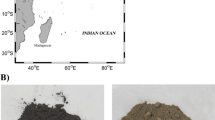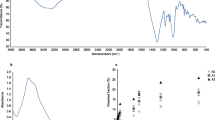Abstract
Due to their unique physicochemical characteristics, nanomaterials exhibit many excellent properties and functions, leading to their applications in numerous fields. The large-scale production and widespread application of nanomaterials have inevitably resulted in their release into the environment, especially the water environment. Several studies have confirmed that exposure to nanomaterials can be toxic to aquatic organisms. However, few studies have focused on the effects of nanomaterial exposure on growth and immunity in crustaceans. In the present study, juvenile Macrobrachium rosenbergii were exposed to different concentrations of titanium dioxide (TiO2)/activated carbon (AC) composite nanomaterial (0.1 and 0.5 mg/L) for 45 days. The effects of nanoparticle exposure on digestion and antioxidant-related enzyme activities, as well as the expression of growth and immunity-related genes and signaling pathway, were evaluated. Our results show that in response to low concentration of TiO2/AC nanoparticle (0.1 mg/L), most of the enzyme activities related to digestion and antioxidation (TPS, LPS, AMS, SOD, and CAT) were diminished. On the contrary, the GSH-Px activity increased under the 0.1 mg/L group of TiO2/AC nanoparticle concentration. Additionally, the level of digestive and antioxidant enzyme activities we detected was increased when exposed to 0.5 mg/L TiO2/AC nanoparticle. By comparison to the expression level of growth-related genes in the control group, MSTN, CaBP, E75, Raptor, EcR, and EGF were significantly inhibited at 0.1 and 0.5 mg/L concentrations of TiO2/AC nanoparticle, whereas the expression level of genes (TLR, JAK, STAT, PPAF, ACP, and AKP) related to immunity was increased when exposed to different concentrations of TiO2/AC nanoparticle. Compared with the control group (0 mg/L concentration), 5166 DEGs were identified in the TiO2/AC nanoparticle group, and a large number of DEGs were involved in molting, energy metabolism, stress tolerance, and germ cell development. Moreover, KEGG analysis revealed that many DEGs were assigned into signaling pathways related to metabolic growth and immune stress. These results showed that exposure to TiO2/AC nanoparticle will result in the changes of enzyme activity and routine mRNA expression, suggesting that TiO2/AC nanoparticle which existed in aquatic environment might affect the physiology of M. rosenbergii. This study will provide significant information for the evaluation of nanomaterial toxicity on aquatic crustaceans.





Similar content being viewed by others
Data availability
All data generated or analyzed during this study are included in this published article.
References
Aderem A, Ulevitch JR (2000) Toll-like receptors in the induction of the innate immune response. Nature 406(6797):782–787. https://doi.org/10.1038/35021228
Anle Xu et al (2020) Effects of dietary Chinese herbal medicines mixture on feeding attraction activity, growth performance, nonspecific immunity and digestive enzyme activity of Japanese seabass (Lateolabrax japonicus). Aquaculture Reports 17:100304. https://doi.org/10.1016/j.aqrep.2020.100304
Bhoyar Rahul C et al (2017) Neuroanatomical demonstration of calbindin 2a- and calbindin 2b-like calcium binding proteins in the early embryonic development of zebrafish: mRNA study. Int J Dev Neurosci 60:26–33. https://doi.org/10.1016/j.ijdevneu.2017.03.012
Bhuvaneshwari M et al (2018) Toxicity and trophic transfer of P25 TiO2 NPs from Dunaliella salina to Artemia salina: effect of dietary and waterborne exposure. Environ Res 160:39–46. https://doi.org/10.1016/j.envres.2017.09.022
Birgit Z et al (1997) Glutathione depletion in fibroblasts is the basis for apoptosis-induction by endogenous reactive oxygen species. Cell Death Differ 4(5):388–395. https://doi.org/10.1038/sj.cdd.4400258
Birgit K, TeresaFernandes F, Mark Jepson A et al (2012) Interspecies comparisons on the uptake and toxicity of silver and cerium dioxide nanoparticles. Environ Toxicol Chem 31(1):144–154
Bruno L, Jules H (2007) The host defense of Drosophila melanogaster. Annu Rev Immunol 25(1):697–743. https://doi.org/10.1146/annurev.immunol.25.022106.141615
Cahu C et al (2004) Expression and activities of pancreatic enzymes in developing sea bass larvae (Dicentrarchus labrax) in relation to intact and hydrolyzed dietary protein; involvement of cholecystokinin. Aquac 238(1):295–308. https://doi.org/10.1016/j.aquaculture.2004.04.013
Carlo P et al (2014) Ecotoxicity of pristine graphene to marine organisms. Ecotoxicol Environ Saf 101:138–145. https://doi.org/10.1016/j.ecoenv.2013.11.008
Chen JS et al (2003) Application of nano TiO2 towards polluted water treatment combined with electro-photochemical method. Water Res 37(16):3815–3820. https://doi.org/10.1016/s0043-1354(03)00332-4
Clemente Z et al (2014) Toxicity assessment of TiO2 nanoparticles in zebrafish embryos under different exposure conditions. Aquat Toxicol 147:129–139. https://doi.org/10.1016/j.aquatox.2013.12.024
Cristina B et al (2013) In vivo effects of n-TiO2 on digestive gland and immune function of the marine bivalve Mytilus galloprovincialis. Aquat Toxicol 132–133:9–18. https://doi.org/10.1016/j.aquatox.2013.01.014
Donglei Wu et al (2019) Effects and transcriptional responses in the hepatopancreas of red claw crayfish Cherax quadricarinatus under cold stress. J Therm Biol 85:102404. https://doi.org/10.1016/j.jtherbio.2019.102404
Ellis RP et al (2011) Immunological function in marine invertebrates: responses to environmental perturbation. Fish Shellfish Immunol 30(6):1209–1222. https://doi.org/10.1016/j.fsi.2011.03.017
Enrique N et al (2008) Environmental behavior and ecotoxicity of engineered nanoparticles to algae, plants, and fungi. Ecotoxicol 17(5):372–386. https://doi.org/10.1007/s10646-008-0214-0
Fadri SG et al (2009) Modeled environmental concentrations of engineered nanomaterials (TiO2, ZnO, Ag, CNT, Fullerenes) for different regions. Environ Sci Technol 43(24):9216–9222
FAO (2020). FoodandAgricultureOrganization.
Flaccavento A et al (2020) Morphostructural and immunohistochemical study for evaluation of nano-TiO2 toxicity in Armadillo officinalis Duméril, 1816 (Crustacea, Isopoda, Oniscidea). Microsc Res Tech 83(3):297–303. https://doi.org/10.1002/jemt.23413
Francesco R, Elisa GM (2014) Oxidative pathways of chemical toxicity and oxidative stress biomarkers in marine organisms. Mar Environ Res 93:106–117. https://doi.org/10.1016/j.marenvres.2013.07.006
Francesco R et al (2011) Molecular and biochemical biomarkers in environmental monitoring: a comparison of biotransformation and antioxidant defense systems in multiple tissues. Aquatic Toxicol 105(3):56–66. https://doi.org/10.1016/j.aquatox.2011.06.014
Gao Y et al (2016) Analysis of chip morphology and surface topography in modulation assisted machining. Int J Mech Sci 111–112:88–100. https://doi.org/10.1016/j.ijmecsci.2016.03.025
Iswarya V et al (2015) Combined toxicity of two crystalline phases (anatase and rutile) of Titania nanoparticles towards freshwater microalgae: Chlorella sp. Aquat Toxicol 161:154–169. https://doi.org/10.1016/j.aquatox.2015.02.006
Joseph K, Maier Kurt J (2022) Evaluation of silver nanoparticle acute and chronic effects on freshwater amphipod (Hyalella azteca). Aquat Toxicol 242:106016. https://doi.org/10.1016/j.aquatox.2021.106016
Keller AA et al (2013) Global life cycle releases of engineered nanomaterials. J Nanopart Res 15(6):1692–1694
Klaine SJ et al (2012) Nanomaterials in the environment: behavior, fate, bioavailability, and. Environ Toxicol Chem 27(9):1825–51. https://doi.org/10.1002/etc.2027
Wang X et al (2009) Degradation of methyl orange by composite photocatalysts nano-TiO2 immobilized on activated carbons of different porosities. J Hazard Mater 169(1–3):1061–1067. https://doi.org/10.1016/j.jhazmat.2009.04.058
Wang X et al (2012) Immune response and energy metabolism of Chlamys farreri under Vibrio anguillarum challenge and high temperature exposure. Fish Shellfish Immunol 33(4):1016–1026. https://doi.org/10.1016/j.fsi.2012.08.026
Li X et al (2012) Aggregation kinetics and dissolution of coated silver nanoparticles. Langmuir : the ACS journal of surfaces and colloids 28(2). https://doi.org/10.1021/la202328n
Linwei Y et al (2019) A JAK-STAT pathway target gene encoding a single WAP domain (SWD)-containing protein from Litopenaeus vannamei. Fish Shellfish Immunol 89:555–563. https://doi.org/10.1016/j.fsi.2019.04.046
Liu Z et al (2020) Polystyrene nanoplastic induces ROS production and affects the MAPK-HIF-1/NFkB-mediated antioxidant system in Daphnia pulex. Aquat Toxicol 220:105420. https://doi.org/10.1016/j.aquatox.2020.105420
Lu L et al (2018) Acute toxicity and safety assessment of nano-TiO2 to aquatic organisms. Acta Agric Zhejiangensis 30(03):437–444
Luo BY et al (2021) Transcriptional changes revealed water acidification leads to the immune response and ovary maturation delay in the Chinese mitten crab Eriocheir sinensis. ComparativeComp Biochem Physiol D-Genomics Proteomics 39https://doi.org/10.1016/j.cbd.2021.100868
Marty R (2014) Development of a semipurified test diet for determining amino acid requirements of Florida pompano Trachinotus carolinus reared under low-salinity conditions. Aquaculture 420–421:49–56. https://doi.org/10.1016/j.aquaculture.2013.10.038
Neetu S et al (2022) Muscle growth in targeted knockout common carp (Cyprinus carpio) mstn gene with low off-target effects. Aquac 547:737423. https://doi.org/10.1016/j.aquaculture.2021.737423
Notarianni M et al (2016) Synthesis and applications of carbon nanomaterials for energy generation and storage. Beilstein J Nanotechnol 7:149–196. https://doi.org/10.3762/bjnano.7.17
Priya Jose TA et al (2010) Molecular characterization of an ecdysone inducible gene E75 of Chinese shrimp Fenneropenaeus chinensis and elucidation of its role in molting by RNA interference. Comp Biochem Physiol b: Biochem Mol Biol 156(3):149–157. https://doi.org/10.1016/j.cbpb.2010.02.004
Pugazhendhi A et al (2018) Inorganic nanoparticles: a potential cancer therapy for human welfare. Int J Pharm 539(1):104–111. https://doi.org/10.1016/j.ijpharm.2018.01.034
Qingsheng C et al (2019) Low-dose microcystins MC-LR induced hepatopancreas injury and apoptosis in Macrobrachium rosenbergii. Asian J Ecotoxicol 15(2):171–179. https://doi.org/10.7524/AJE.1673⁃5897.20190429001
Robbie L et al (2002) Two TOR complexes, only one of which is rapamycin sensitive, have distinct roles in cell growth control. Mol Cell 10(3):457–468. https://doi.org/10.1016/S1097-2765(02)00636-6
Sarah H et al (2019) Comparative multi-generation study on long-term effects of pristine and wastewater-borne silver and titanium dioxide nanoparticles on key lifecycle parameters in Daphnia magna. NanoImpact 14:100163. https://doi.org/10.1016/j.impact.2019.100163
Scown TM et al (2010) Review: Do engineered nanoparticles pose a significant threat to the aquatic environment? Crit Rev Toxicol 40(7):653–670
Xin F (2016) Gene cloning and functional study on the important genes of mTOR signalingin Litopenaeus vannamei Master of Bioengineering The University of Chinese Academy of Sciences.
Yesim O et al (2016) Determination of TiO2 and AgTiO2 nanoparticles in Artemia salina: toxicity, morphological changes, uptake and depuration. Bull Environ Contam Toxicol 96(1):36–42. https://doi.org/10.1007/s00128-015-1634-1
Ying Y (2012) Study on preparation and photocatalytic activity of nano-titania/activated carbon composite materials based on self-assembled monolayers (SAMs), Wuhan University of Technology.
Yearbooks China Fishery Statistics (2021). China fishery statistics yearbooks.
Yokel Robert A and MacPhail Robert C (2011). Engineered nanomaterials: exposures, hazards, and risk prevention. J Occup Med Toxicol 6(1).
Yonping H et al (2021) Study on TiO2/GO composite and its application in environmental pollution treatment. New Chem Mater 49(07):33–38
Yu Su et al (2020) Functional expression patterns of four ecdysteroid receptor isoforms indicate their different functions during vitellogenesis of Chinese mitten crab, Eriocheir sinensis. Comp Bochem Physiol Part a: Mol Integr Physiol 248:110754. https://doi.org/10.1016/j.cbpa.2020.110754
Zao Y et al (2014) Cloning and analysis of full length cDNA of prophenoloxidase activating factor in Litopenaeus vannamei. J Fish China 38(08):1068–1078
Zhang X et al (2019) Evaluation of soybean meal as alternative to fish meal in diet for juvenile Asian red-tailed catfish (Hemibagrus wyckioides). Aquac Nutr 25(5):1036–1049. https://doi.org/10.1111/anu.12921
Zhiquan L et al (2019) Effects of microplastics on the innate immunity and intestinal microflora of juvenile Eriocheir sinensis. Sci Total Environ 685:836–846. https://doi.org/10.1016/j.scitotenv.2019.06.265
Funding
This work was supported by the Natural Science Foundation of China (project number 31902348), the Taizhou Science and Technology Support Plan (Agriculture) (project number TN202110), and the Jiangsu Seed Industry Revitalization Project (project number JBGS (2021) 121).
Author information
Authors and Affiliations
Contributions
KYM, SPZ, and GFQ supervised the project. KYM and SPZ designed the experiments. ZQG, JBZ, XL, JHG, and JBF conducted the experiments. ZQG, JBZ, and XL conducted the data analyses. ZQG and JBZ wrote the manuscript. KYM and JLL finalized the manuscript.
Corresponding author
Ethics declarations
Ethics approval
Not applicable.
Consent for publication
Not applicable.
Competing interests
The authors declare no competing interests.
Additional information
Responsible Editor: Bruno Nunes
Publisher's note
Springer Nature remains neutral with regard to jurisdictional claims in published maps and institutional affiliations.
Supplementary Information
Below is the link to the electronic supplementary material.
Rights and permissions
Springer Nature or its licensor (e.g. a society or other partner) holds exclusive rights to this article under a publishing agreement with the author(s) or other rightsholder(s); author self-archiving of the accepted manuscript version of this article is solely governed by the terms of such publishing agreement and applicable law.
About this article
Cite this article
Guo, Z., Zuo, J., Liu, X. et al. Effects of titanium dioxide (TiO2)/activated carbon (AC) nanoparticle on the growth and immunity of the giant freshwater prawn, Macrobrachium rosenbergii: potential toxicological risks to the aquatic crustaceans. Environ Sci Pollut Res 30, 33322–33333 (2023). https://doi.org/10.1007/s11356-022-24555-8
Received:
Accepted:
Published:
Issue Date:
DOI: https://doi.org/10.1007/s11356-022-24555-8




